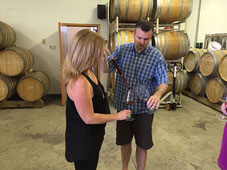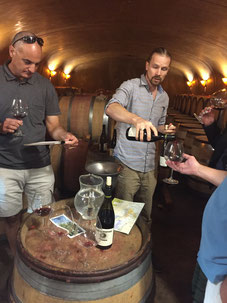
The event was a friend-raiser for the University of Oregon Museum of Natural and Cultural History. The speaker: southern Oregon climatologist Gregory Jones, who has
been studying Oregon wine and climate change for 25 years. The subject: Terroir. "A stretch of land limited by its agricultural capacity.... What is unique to a given region: soil, geology,
geographic identity, sense of place, somewhereness." Yet you have to get the climate to work with the variety, landscape, soil, output, style, quality and consumer expectation. "If you don't get
the climate right, nothing else matters."
While global average warming has plateaued the last four years - partly, he said, because of the absorption of heat by the oceans - the world is still on a steady warming cycle. Instead of
expounding on the reasons for that upward trend, he focused on the effects of climate change on grapes and wine. What I found most compelling was a graphic he displayed on the so-called "sweet
spots" for wine - the optimal average temperature range for a variety of grapes. Of the 30 on the chart, Pinot Noir had the smallest sweet spot, with tables grapes, cabernet sauvignon and merlot
among the largest. If the average temperature for a season is below the sweet spot, wines can appear unripe and unbalanced; if temperatures are too high, high sugar can result in over-ripe
flavors and high alcohol. Taking the optimum temperature range for the grapes to express themselves - and the soil and region - he pointed out what happens by moving the temperature ranges as
they have warmed over the last 25 years; some grapes - especially the colder-loving whites - may no longer be suitable for certain areas, while warm-loving varieties from Greece and Portugal, for
example, may come into the play.
He used grenache as an example of warming in Europe. North Africa and the far southern reaches of Italy, Spain and Greece used to dominate the market; old growers have switched to other varieties
while France and Germany have taken up the grenache slack. Harvest times on the Rhine alone can be 25 days earlier than they were 30 years ago.
All seasons matter, even winter. "You may get sporadic bud break with a warmer dormant season." Extreme temperature variations can affect bud break and flowering, affecting yields, along with the
usual cautions for weather phenomena such as heavy rain, sleet and frost with extreme heat and drought on the other side of the ledger. And then you have the new fungus or pests that come with
the warmer temps. The stink bug is the current grape-grower enemy No. 1.
Will climate indeed continue to change? Jones expects so - and for grape growers and wine makers to keep their crops in the sweet spot.





Write a comment
Custom essay writing service (Monday, 27 November 2017 04:39)
Thanks a lot for the kind of perfect topic I have not a lot of information about it but I have got an extra unique info in your unique post. Perfect description you have provided thanks for sharing.
chrome keyboard shortcuts (Friday, 14 September 2018 02:39)
Thanks for this impressive article here on our website you will get the google chrome keyboard shortcuts that helps in making your work easier on google chrome.
assignment writing services uk (Sunday, 21 October 2018 03:48)
I’m excited to uncover this page. I need to to thank you for ones time for this particularly fantastic read!! I definitely really liked every part of it and i also have you saved to fav to look at new information in your site.
[url=https://www.mhrwriter.co.uk/assignment-writing-services]assignment writing services uk[/url] (Sunday, 21 October 2018 03:49)
I’m excited to uncover this page. I need to to thank you for ones time for this particularly fantastic read!! I definitely really liked every part of it and i also have you saved to fav to look at new information in your site.